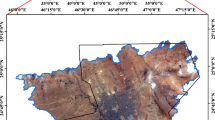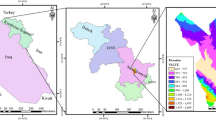Abstract
This study was conducted for the Nagwan watershed of the Damodar Valley Corporation (DVC), Hazaribagh, Bihar, India. Geographic Information System (GIS) was used to extract the hydrological parameters of the watershed from the remote sensing and field data. The Digital Elevation Model (DEM) was prepared using contour map (Survey of India, 1:50000 scale) of the watershed. The EASI/PACE GIS software was used to extract the topographic features and to delineate watershed and overland flow-paths from the DEM. Land use classification were generated from data of Indian Remote Sensing Satellite (IRS-1B—LISS—II) to compute runoff Curve Number (CN). Data extracted from contour map, soil map and satellite imagery, viz. drainage basin area, basin shape, average slope of the watershed, main stream channel slope, land use, hydrological soil groups and CN were used for developing an empirical model for surface runoff prediction. It was found that the model can predict runoff reasonably well and is well suited for the Nagwan watershed. Design of conservation structures can be done and their effects on direct runoff can be evaluated using the model. In broader sense it could be concluded that model can be applied for estimating runoff and evaluating its effect on structures of the Nagwan watershed.
Similar content being viewed by others
References
Agostino, A. D., Stagnhellini and Trisono, L. G. (1993). A FORTRAN program for preliminary extraction of drainage networks based on a DEM. Computers and Geosciences,19(7):981–1106.
Bagley, J. M., Jeppson, R. W. and Milligan, C. H. (1964). Water yield in Utah. Special Report-8, Utah Agricultural Experiment Station, Utah State University, Logan, Utah.
Burrough, P. A. (1986). Principles of Geographic Information Systems for Land Resources Assessment. Clarendom Press, Oxford, United Kingdom.
Chakravorty, A. K. (1993). Strategies for watershed management planning using remote sensing techniques. Journal of Indian Society of Remote Sensing,21(2):87–98.
Das, S. N., Narula, N. K. and Laurin, R. (1992). Runoff potential indices of watersheds in Tilaiya catchment (Bihar) through use of remote sensing and geographic information system. Photonirvachak,20(4):207–221.
Decoursey, D. G. and Dea, R. B. (1974). General aspects of multivariates Analysis with application to some problem in hydrology. Proceeding Symposium on Statistical Hydrology, U. S. D. A. Miscellaneous Publication No. 1275, Washington, D. C, pp.47–68.
Dhruva Narayana, V. V. (1993). Soil and Water conservation research in India, pp. 146–151. Indian Council of Agricultural Research, Krishi Anusandhan Bhavan, Pusa, New Delhi.
Garg, P. K. (1996). Use of digital elevation model in runoff modelling. In Surface Water Hydrology (V. P. Singh and B. Kumar ed.),20(4):207–221.
Hill J M., Singh, V. P. and Aminian, H. (1987). A computerised data base for flood prediction modelling. Water Resources Bulletin, American Water Resources Association,23:21–27.
Jenson, S. K. and Dominque, J. O. (1988). Extracting topographic structures from digital elevation data for GIS analysis. Photogrammetric Engineering and Remote Sensing,54(11): 1593–1600.
Jose, C. S. and Das, D. C. (1982). Geomorphic prediction models for sediment production rate and intensive priorities of watershed in Mayurakshi catchment. Proceedings of the International Symposium on Hydrological Aspects of Mountainous Watershed, School of Hydrology, University of Roorkee, 4–6 November, 1982,1:15–23.
Martz, L. W. and Garbrecht, J. (1992). Numerical definition of drainage networks and subcatchment areas from digital elevation models. Computers and Geosciences,18(6):747–761.
Meyer, S. P., Salem, T. H. and Labadie, J. W. (1993). Geographical information systems in urban storm water management. Journal of Water Resources Planning and Management,119(6):206–228.
Misra, N. (1988). Watershed runoff modelling- A case study. Journal of Institution of Engineers,68:91–95
Moore, I. D., Grayson, R. B. and Ladson, A. R. (1991). Digital terrain modelling: A review of hydrological, geomorphologic and biological applications. Hydrological Process,5(l):3–30.
NagaRaju, B. (1987). Mathematical modelling of hydrological events. M. Tech. Dissertation, Department of Agricultural and Food Engineering, Indian Institute of Technology, Kharagpur, India.
PCI Inc. (1994). EASI/PACE image analysis system manual, version 5.3, PCI Incorporated, Richmond Hill, Ontario, Canada; Vol. I & II, variously paged.
Ragan, R. M. and Jackson, T. J. (1980). Runoff synthesis using Landsat and SCS model. Journal of Hydraulic Division, ASCE,106(HY5):667–68.
Ross, M. A. and Tara, P. D. (1993). Integrated hydrologie modelling with geographic information systems. Journal of Water Resources Planning and Management, ASCE,119(2):29–140.
Schultz, G. A. (1988). Remote sensing in hydrology, Journal of Hydrology,100:239–265.
Singh, V. P. (1995). Computer models of watershed hydrology, Water Resources Publications, P.O.B. 260026, Highlands Ranch, Colorado 80126–0026, USA.
Smith, M. B. and Andrej, V. (1994). Data set derivation for GIS based urban hydrological modelling. Photogrammetric Engineering and Remote Sensing,60(1):67–76.
Stuebe, M. and Johnston, D. (1990). Runoff volume estimation using GIS techniques. Water Resources Bulletin,26(4):111–116.
Soil Conservation Service (1972). Hydrology. In SCS National Engineering Handbook, DC. US Department of Agriculture, Section 4.
Taylor, A. B. and Schwartz, H. E. (1952). Unit hydrograph lag and peak flow related to basin characteristics. Transaction of American Geophysics Union,33:235.
Tiwari, K. N., Kanan, N., Singh, R. D. and Ghosh, S. K. (1997). Watershed parameters extraction using GIS and remote sensing for hydrologic modelling. ASIAN-PACIFIC Remote Sensing and GIS Journal,10(1):43–52.
Tiwari, K. N., Kumar, P., Sebastian, M. and Pal, D. K. (1991). Hydrological modelling for runoff determination. Water Resources Development,7(3):178–184.
USDA-SCS (1972). National Engineering Handbook, Hydrology Section 4, Chapters 4–10.
Wang, L. L. and Huber, A. C. (1967). Estimating water yield in Utah by principal component analysis. Report Prwg 35a-l, Utah water Research Laboratory, Logan, Utah.
White, D. (1988). Grid based application of runoff curve numbers. Journal of Water Resources Planning and Management Division, ASCE,114(6):601–612.
Zollweg, J. A., Gburek, W. J. and Steenhuis, T. S. (1996). SMORMOD-A GIS integrated rainfall-runoff model. Transactions of ASAE,39(4):299–1307.
Author information
Authors and Affiliations
About this article
Cite this article
Tripathi, M.P., Panda, R.K., Pradhan, S. et al. Runoff modelling of a small watershed using satellite data and GIS. J Indian Soc Remote Sens 30, 39–52 (2002). https://doi.org/10.1007/BF02989975
Received:
Revised:
Issue Date:
DOI: https://doi.org/10.1007/BF02989975




